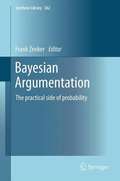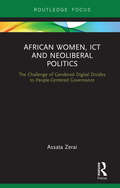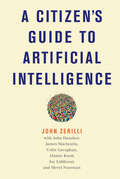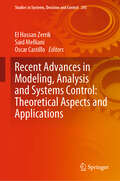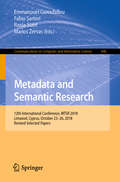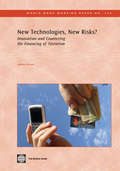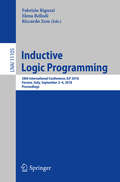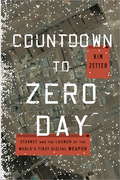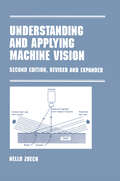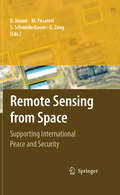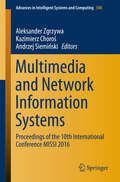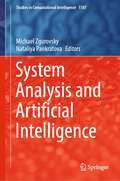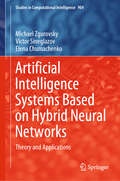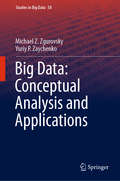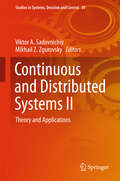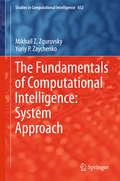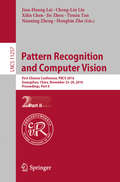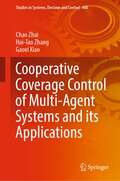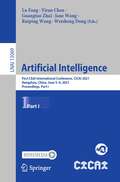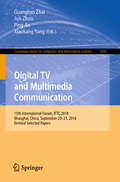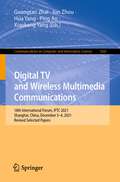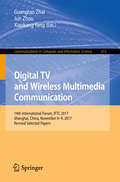- Table View
- List View
Bayesian Argumentation: The practical side of probability (Synthese Library #362)
by Frank ZenkerRelevant to, and drawing from, a range of disciplines, the chapters in this collection show the diversity, and applicability, of research in Bayesian argumentation. Together, they form a challenge to philosophers versed in both the use and criticism of Bayesian models who have largely overlooked their potential in argumentation. Selected from contributions to a multidisciplinary workshop on the topic held in Sweden in 2010, the authors count linguists and social psychologists among their number, in addition to philosophers. They analyze material that includes real-life court cases, experimental research results, and the insights gained from computer models. The volume provides, for the first time, a formal measure of subjective argument strength and argument force, robust enough to allow advocates of opposing sides of an argument to agree on the relative strengths of their supporting reasoning. With papers from leading figures such as Michael Oaksford and Ulrike Hahn, the book comprises recent research conducted at the frontiers of Bayesian argumentation and provides a multitude of examples in which these formal tools can be applied to informal argument. It signals new and impending developments in philosophy, which has seen Bayesian models deployed in formal epistemology and philosophy of science, but has yet to explore the full potential of Bayesian models as a framework in argumentation. In doing so, this revealing anthology looks destined to become a standard teaching text in years to come.
African Women, ICT and Neoliberal Politics: The Challenge of Gendered Digital Divides to People-Centered Governance (Routledge Studies on Gender and Sexuality in Africa)
by Assata ZeraiHow can we promote people-centered governance in Africa? Cell phones/ information and communications technology (ICT) are shown to be linked to neoliberal understandings of more democratic governance structures, defined by the Worldwide Governance Indicators as: the rule of law, corruption-control, regulation quality, government effectiveness, political stability/no violence, and voice and accountability. However, these indicators fall short: they do note emphasize gender equity or pro-poor policies. Writing from an African feminist scholar-activist perspective, Assata Zerai emphasizes the voices of women in two ways: (1) she examines how women's access to ICT makes a difference to the success of people-centered governance structures; and (2) she demonstrates how African women's scholarship, too often marginalized, must be used to expand and redefine the goals and indicators of democratice governance in African countries. Challenging the status quo that praises the contributions of cell phones to the diffusion of knowledge and resultant better governance in Africa, this book is an important read for scholars of politics and technology, gender and politics, and African Studies.
A Citizen's Guide to Artificial Intelligence
by John ZerilliA concise but informative overview of AI ethics and policy.Artificial intelligence, or AI for short, has generated a staggering amount of hype in the past several years. Is it the game-changer it's been cracked up to be? If so, how is it changing the game? How is it likely to affect us as customers, tenants, aspiring home-owners, students, educators, patients, clients, prison inmates, members of ethnic and sexual minorities, voters in liberal democracies? This book offers a concise overview of moral, political, legal and economic implications of AI. It covers the basics of AI's latest permutation, machine learning, and considers issues including transparency, bias, liability, privacy, and regulation.
Houdini On the Spot: Power User Tips and Techniques (On The Spot {{series}} Ser.)
by Craig ZerouniPacked with more than 350 techniques, this book delivers what you need to know-on the spot. Its concise presentation of professional techniques is suited to experienced artists whether you are:* Migrating from another visual effects application* Upgrading to Houdini 9* Seeking a handy reference to raise your proficiency with HoudiniHoudini On the Spot presents immediate solutions in an accessible format. It clearly illustrates the essential methods that pros use to get the job done efficiently and creatively. Screenshots and step-by-step instructions show you how to:* Navigate and manipulate the version 9 interface* Create procedural models that can be modified quickly and efficiently with Surface Operators (SOPs) * Use Particle Operators (POPs) to build complex simulations with speed and precision* Minimize the number of operators in your simulations with Dynamics Operators (DOPs) * Extend Houdini with customized tools to include data or scripts with Houdini Digital Assets (HDAs) * Master the version 9 rendering options including Physically Based Rendering (PBR), volume rendering and motion blur* Quickly modify timing, geometry, space and rotational values of your animations with Channel Operators (CHOPs)* Create and manipulate elements with Composite Operators (COPs); Houdini's full-blown compositor toolset* Make your own SOPs, COPs, POPs, CHOPs, and shaders with the Vector Expressions (VEX) shading language * Configure the Houdini interface with customized environments and hotkeys* Mine the treasures of the dozens of standalone applications that are bundled with Houdini
Recent Advances in Modeling, Analysis and Systems Control: Theoretical Aspects and Applications (Studies in Systems, Decision and Control #243)
by El Hassan Zerrik Said Melliani Oscar CastilloThis book describes recent developments in a wide range of areas, including the modeling, analysis and control of dynamical systems, and explores related applications. The book provided a forum where researchers have shared their ideas, results on theory, and experiments in application problems. The current literature devoted to dynamical systems is quite large, and the authors’ choice for the considered topics was motivated by the following considerations. Firstly, the mathematical jargon for systems theory remains quite complex and the authors feel strongly that they have to maintain connections between the people of this research field. Secondly, dynamical systems cover a wider range of applications, including engineering, life sciences and environment. The authors consider that the book is an important contribution to the state of the art in the fuzzy and dynamical systems areas.
Metadata and Semantic Research: Third International Conference, Mtsr 2009, Milan, Italy, October 1-2, 2009. Proceedings (Communications in Computer and Information Science #46)
by Marios Zervas Rania Siatri Fabio Sartori Emmanouel GaroufallouThis book constitutes the thoroughly refereed proceedings of the 12th International Conference on Metadata and Semantic Research, MTSR 2018, held in Limassol, Cyprus, on October 23-26, 2018. The 19 full and 16 short papers presented were carefully reviewed and selected from 77 submissions. The papers are organized in topical sections on metadata, linked data, semantics, ontologies and SKOS; digital libraries, information retrieval, big, linked, social and open data; cultural collections and applications; Knowledge IT Artifacts (KITA) in professional communities and aggregations; Digital Humanities and Digital Curation (DHC); European and national projects; agriculture, food and environment; open repositories, research information systems and data infrastructures.
New Technologies, New Risks? Innovation and Countering the Financing of Terrorism
by Andrew ZerzanNew financial and communication technologies offer a great opportunity to improve the lives of people everywhere. For instance, millions of impoverished people now have access to the financial system through stored value cards or mobile phones. However, some are concerned that governments are not always aware of these innovations in their jurisdictions. This has prompted fear that fast-moving terrorist groups could expand funding undetected. The fear has led some countries to take a restrictive stance on the technologies' use, either by outright prohibition or by placing unnecessary limitations that deter market development. Authorities are therefore challenged to tackle the double-sided nature of technological advancement: promoting security and economic growth. 'New Technologies, New Risks? Innovation and Countering the Financing of Terrorism' explores how money flows via these mediums, risks they pose, and how governments have mitigated the risks.
Inductive Logic Programming: 28th International Conference, ILP 2018, Ferrara, Italy, September 2–4, 2018, Proceedings (Lecture Notes in Computer Science #11105)
by Riccardo Zese Elena Bellodi Fabrizio RiguzziThis book constitutes the refereed conference proceedings of the 28th International Conference on Inductive Logic Programming, ILP 2018, held in Ferrara, Italy, in September 2018. The 10 full papers presented were carefully reviewed and selected from numerous submissions. Inductive Logic Programming (ILP) is a subfield of machine learning, which originally relied on logic programming as a uniform representation language for expressing examples, background knowledge and hypotheses. Due to its strong representation formalism, based on first-order logic, ILP provides an excellent means for multi-relational learning and data mining, and more generally for learning from structured data.
Countdown to Zero Day: Stuxnet and the Launch of the World's First Digital Weapon
by Kim ZetterTop cybersecurity journalist Kim Zetter tells the story behind the virus that sabotaged Iran's nuclear efforts and shows how its existence has ushered in a new age of warfare--one in which a digital attack can have the same destructive capability as a megaton bomb. In January 2010, inspectors with the International Atomic Energy Agency noticed that centrifuges at an Iranian uranium enrichment plant were failing at an unprecedented rate. The cause was a complete mystery--apparently as much to the technicians replacing the centrifuges as to the inspectors observing them. Then, five months later, a seemingly unrelated event occurred: A computer security firm in Belarus was called in to troubleshoot some computers in Iran that were crashing and rebooting repeatedly. At first, the firm's programmers believed the malicious code on the machines was a simple, routine piece of malware. But as they and other experts around the world investigated, they discovered a mysterious virus of unparalleled complexity. They had, they soon learned, stumbled upon the world's first digital weapon. For Stuxnet, as it came to be known, was unlike any other virus or worm built before: Rather than simply hijacking targeted computers or stealing information from them, it escaped the digital realm to wreak actual, physical destruction on a nuclear facility. In these pages, Wired journalist Kim Zetter draws on her extensive sources and expertise to tell the story behind Stuxnet's planning, execution, and discovery, covering its genesis in the corridors of Bush's White House and its unleashing on systems in Iran--and telling the spectacular, unlikely tale of the security geeks who managed to unravel a sabotage campaign years in the making. But Countdown to Zero Day ranges far beyond Stuxnet itself. Here, Zetter shows us how digital warfare developed in the US. She takes us inside today's flourishing zero-day "grey markets," in which intelligence agencies and militaries pay huge sums for the malicious code they need to carry out infiltrations and attacks. She reveals just how vulnerable many of our own critical systems are to Stuxnet-like strikes, from nation-state adversaries and anonymous hackers alike--and shows us just what might happen should our infrastructure be targeted by such an attack. Propelled by Zetter's unique knowledge and access, and filled with eye-opening explanations of the technologies involved, Countdown to Zero Day is a comprehensive and prescient portrait of a world at the edge of a new kind of war.
Understanding and Applying Machine Vision, Revised and Expanded
by Nello ZeuchA discussion of applications of machine vision technology in the semiconductor, electronic, automotive, wood, food, pharmaceutical, printing, and container industries. It describes systems that enable projects to move forward swiftly and efficiently, and focuses on the nuances of the engineering and system integration of machine vision technology.
Remote Sensing from Space
by Gunter Zeug Martino Pesaresi Stefan Schneiderbauer Bhupendra JasaniThis volume provides the reader with an overview of the state-of-the-art Earth Observation (EO) related research that deals with national and international security. An interdisciplinary approach was adopted in this book in order to provide the reader with a broad understanding on the uses of remote sensing technologies. The book therefore comprises management aspects (issues and priorities of security research, crisis response), applied methodologies and process chains (treaty monitoring, estimation of population densities and characteristics, border permeability models, damage assessment) and the latest developments in generic tools (feature recognition, change detection and visualization). Moreover, issues of data sharing and standards, as well as new approaches to training security relevant techniques, are addressed. The contributing authors are leading researchers and experts from private companies, national research institutions and international organizations, all of whom were brought together under the aegis of the European research project GMOSS (Global Monitoring for Security and Stability). This book is tailored for the scientific community that deals with the application of EO data, as well as project managers and decision makers working in the field of security having an interest in technical solutions. The integrative use of many figures and sample images are ideal in enabling the non-technical reader to grasp quickly the modern technologies that are being researched in the area of civil security.
Multimedia and Network Information Systems
by Aleksander Zgrzywa Kazimierz Choroś Andrzej SiemińskiDiscusses a broad scope of subject matters including multimedia systems in their widest sense, web systems and network technologies. This monograph also includes texts which deals with traditional information systems that draw on the experience of the multimedia and network systems.
System Analysis and Artificial Intelligence (Studies in Computational Intelligence #1107)
by Michael Zgurovsky Nataliya PankratovaThis book contains the latest scientific work of Ukrainian scientists and their colleagues from other countries of the world in three interrelated areas: systems analysis, artificial intelligence and data mining. The included articles present the theoretical foundations and practical applications of the latest tools and methods of artificial intelligence, scenario planning, decision making and computational intelligence for important areas of human activity. The tools and methods presented in the book are continuously evolving and finding new applications across various fields, contributing to advancements and efficiencies in different industries: healthcare, finance, retail and E-commerce, manufacturing and industrial automation, transportation and logistics advancements and cybersecurity. The results of the book are useful to teachers, scientists, graduate students of universities and managers of large companies specializing in strategic planning, engineering design of complex systems, decision-making, optimization of operations and other related fields of knowledge and practice.
Artificial Intelligence Systems Based on Hybrid Neural Networks: Theory and Applications (Studies in Computational Intelligence #904)
by Michael Zgurovsky Victor Sineglazov Elena ChumachenkoThis book is intended for specialists as well as students and graduate students in the field of artificial intelligence, robotics and information technology. It is will also appeal to a wide range of readers interested in expanding the functionality of artificial intelligence systems. One of the pressing problems of modern artificial intelligence systems is the development of integrated hybrid systems based on deep learning. Unfortunately, there is currently no universal methodology for developing topologies of hybrid neural networks (HNN) using deep learning. The development of such systems calls for the expansion of the use of neural networks (NS) for solving recognition, classification and optimization problems. As such, it is necessary to create a unified methodology for constructing HNN with a selection of models of artificial neurons that make up HNN, gradually increasing the complexity of their structure using hybrid learning algorithms.
Big Data: Conceptual Analysis and Applications (Studies in Big Data #58)
by Michael Z. Zgurovsky Yuriy P. ZaychenkoThe book is devoted to the analysis of big data in order to extract from these data hidden patterns necessary for making decisions about the rational behavior of complex systems with the different nature that generate this data. To solve these problems, a group of new methods and tools is used, based on the self-organization of computational processes, the use of crisp and fuzzy cluster analysis methods, hybrid neural-fuzzy networks, and others. The book solves various practical problems. In particular, for the tasks of 3D image recognition and automatic speech recognition large-scale neural networks with applications for Deep Learning systems were used. Application of hybrid neuro-fuzzy networks for analyzing stock markets was presented. The analysis of big historical, economic and physical data revealed the hidden Fibonacci pattern about the course of systemic world conflicts and their connection with the Kondratieff big economic cycles and the Schwabe–Wolf solar activity cycles. The book is useful for system analysts and practitioners working with complex systems in various spheres of human activity.
Continuous and Distributed Systems II: Theory and Applications (Studies in Systems, Decision and Control #30)
by Mikhail Z. Zgurovsky Viktor A. SadovnichiyAs in the previous volume on the topic, the authors close the gap between abstract mathematical approaches, such as applied methods of modern algebra and analysis, fundamental and computational mechanics, nonautonomous and stochastic dynamical systems, on the one hand, and practical applications in nonlinear mechanics, optimization, decision making theory and control theory on the other. Readers will also benefit from the presentation of modern mathematical modeling methods for the numerical solution of complicated engineering problems in biochemistry, geophysics, biology and climatology. This compilation will be of interest to mathematicians and engineers working at the interface of these field. It presents selected works of the joint seminar series of Lomonosov Moscow State University and the Institute for Applied System Analysis at National Technical University of Ukraine "Kyiv Polytechnic Institute". The authors come from Brazil, Germany, France, Mexico, Spain, Poland, Russia, Ukraine, and the USA.
The Fundamentals of Computational Intelligence: System Approach
by Mikhail Z. Zgurovsky Yuriy P. ZaychenkoThis monograph is dedicated to the systematic presentation of main trends, technologies and methods of computational intelligence (CI). The book pays big attention to novel important CI technology- fuzzy logic (FL) systems and fuzzy neural networks (FNN). Different FNN including new class of FNN- cascade neo-fuzzy neural networks are considered and their training algorithms are described and analyzed. The applications of FNN to the forecast in macroeconomics and at stock markets are examined. The book presents the problem of portfolio optimization under uncertainty, the novel theory of fuzzy portfolio optimization free of drawbacks of classical model of Markovitz as well as an application for portfolios optimization at Ukrainian, Russian and American stock exchanges. The book also presents the problem of corporations bankruptcy risk forecasting under incomplete and fuzzy information, as well as new methods based on fuzzy sets theory and fuzzy neural networks and results of their application for bankruptcy risk forecasting are presented and compared with Altman method. This monograph also focuses on an inductive modeling method of self-organization - the so-called Group Method of Data Handling (GMDH) which enables to construct the structure of forecasting models almost automatically. The results of experimental investigations of GMDH for forecasting at stock exchanges are presented. The final chapters are devoted to theory and applications of evolutionary modeling (EM) and genetic algorithms. The distinguishing feature of this monograph is a great number of practical examples of CI technologies and methods application for solution of real problems in technology, economy and financial sphere, in particular forecasting, classification, pattern recognition, portfolio optimization, bankruptcy risk prediction under uncertainty which were developed by authors and published in this book for the first time. All CI methods and algorithms are presented from the general system approach and analysis of their properties, advantages and drawbacks that enables practitioners to choose the most adequate method for their own problems solution.
Pattern Recognition and Computer Vision: First Chinese Conference, PRCV 2018, Guangzhou, China, November 23-26, 2018, Proceedings, Part II (Lecture Notes in Computer Science #11257)
by Hongbin Zha Nanning Zheng Tieniu Tan Jie Zhou Xilin Chen Cheng-Lin Liu Jian-Huang LaiThe four-volume set LNCS 11056, 110257, 11258, and 11073 constitutes the refereed proceedings of the First Chinese Conference on Pattern Recognition and Computer Vision, PRCV 2018, held in Guangzhou, China, in November 2018. The 179 revised full papers presented were carefully reviewed and selected from 399 submissions. The papers have been organized in the following topical sections: Part I: Biometrics, Computer Vision Application. Part II: Deep Learning. Part III: Document Analysis, Face Recognition and Analysis, Feature Extraction and Selection, Machine Learning. Part IV: Object Detection and Tracking, Performance Evaluation and Database, Remote Sensing.
Cooperative Coverage Control of Multi-Agent Systems and its Applications (Studies in Systems, Decision and Control #408)
by Chao Zhai Hai-Tao Zhang Gaoxi XiaoThis book highlights cooperative coverage control approaches of multi-agent systems in uncertain environments and their applications in various fields. A novel theoretical formulation of multi-agent coverage is proposed to fulfill the coverage task via divide-and-conquer scheme. By taking workload partition and sweeping operations simultaneously, a distributed sweep coverage algorithm of multi-agent systems is developed to cooperatively complete the workload on the given region, and its input-to-state stability is guaranteed in theory. Moreover, the coverage performance is evaluated by estimating the error between the actual coverage time and the optimal time. Three application scenarios are presented to demonstrate the advantages of cooperative coverage control approaches in missile interception, intelligent transportation systems and environment monitoring, respectively.
Artificial Intelligence: First CAAI International Conference, CICAI 2021, Hangzhou, China, June 5–6, 2021, Proceedings, Part I (Lecture Notes in Computer Science #13069)
by Guangtao Zhai Jane Wang Yiran Chen Lu Fang Ruiping Wang Weisheng DongThis two-volume set LNCS 13069-13070 constitutes selected papers presented at the First CAAI International Conference on Artificial Intelligence, held in Hangzhou, China, in June 2021. Due to the COVID-19 pandemic the conference was partially held online. The 105 papers were thoroughly reviewed and selected from 307 qualified submissions. The papers are organized in topical sections on applications of AI; computer vision; data mining; explainability, understandability, and verifiability of AI; machine learning; natural language processing; robotics; and other AI related topics.
Digital TV and Multimedia Communication: 15th International Forum, IFTC 2018, Shanghai, China, September 20–21, 2018, Revised Selected Papers (Communications in Computer and Information Science #1009)
by Guangtao Zhai Jun Zhou Ping An Xiaokang YangThis book presents revised selected papers from the 15th International Forum on Digital TV and Multimedia Communication, IFTC 2018, held in Shanghai, China, in September 2018.The 39 full papers presented in this volume were carefully reviewed and selected from 130 submissions. They were organized in topical sections on image processing; machine learning; quality assessment; telecommunications; video coding; video surveillance; virtual reality.
Digital TV and Wireless Multimedia Communication: 17th International Forum, IFTC 2020, Shanghai, China, December 2, 2020, Revised Selected Papers (Communications in Computer and Information Science #1390)
by Guangtao Zhai Jun Zhou Hua Yang Ping An Xiaokang YangThis book presents revised selected papers from the 17th International Forum on Digital TV and Wireless Multimedia Communication, IFTC 2020, held in Shanghai, China, in December 2020.The 21 full papers and 16 short papers presented in this volume were carefully reviewed and selected from 120 submissions. They were organized in topical sections on image processing; machine learning; quality assessment; telecommunications; video surveillance; and virtual reality.
Digital TV and Wireless Multimedia Communications: 18th International Forum, IFTC 2021, Shanghai, China, December 3–4, 2021, Revised Selected Papers (Communications in Computer and Information Science #1560)
by Guangtao Zhai Jun Zhou Hua Yang Ping An Xiaokang YangThis book presents revised selected papers from the 18th International Forum on Digital TV and Wireless Multimedia Communication, IFTC 2021, held in Shanghai, China, in December 2021.The 41 papers presented in this volume were carefully reviewed and selected from 110 submissions. They were organized in topical sections on image analysis; quality assessment; target detection; video processing; big data.
Digital TV and Wireless Multimedia Communication
by Guangtao Zhai Jun Zhou Xiaokang YangThis book presents revised selected papers from the 14th International Forum on Digital TV and Wireless Multimedia Communication, IFTC 2017, held in Shanghai, China, in November 2017. The 46 papers presented in this volume were carefully reviewed and selected from 122 submissions. They were organized in topical sections named: image processing; machine learning; quality assessment; social media; telecommunications; video surveillance; virtual reality; computer vision; and image compression.
Performance Analysis of Parallel Applications for HPC
by Jidong Zhai Yuyang Jin Wenguang Chen Weimin ZhengThis book presents a hybrid static-dynamic approach for efficient performance analysis of parallel applications on HPC systems. Performance analysis is essential to finding performance bottlenecks and understanding the performance behaviors of parallel applications on HPC systems. However, current performance analysis techniques usually incur significant overhead. Our book introduces a series of approaches for lightweight performance analysis.We combine static and dynamic analysis to reduce the overhead of performance analysis. Based on this hybrid static-dynamic approach, we then propose several innovative techniques for various performance analysis scenarios, including communication analysis, memory analysis, noise analysis, computation analysis, and scalability analysis. Through these specific performance analysis techniques, we convey to readers the idea of using static analysis to support dynamic analysis.To gain the most from the book, readers should have a basic grasp of parallel computing, computer architecture, and compilation techniques.
